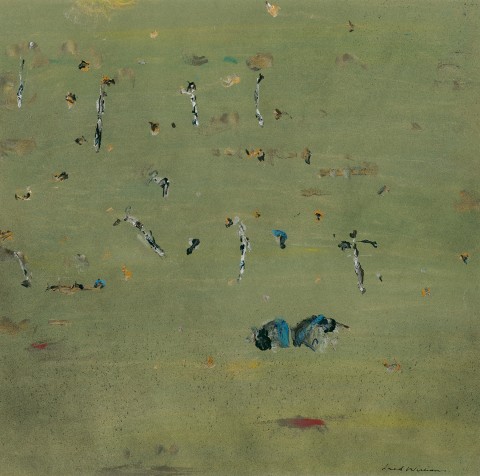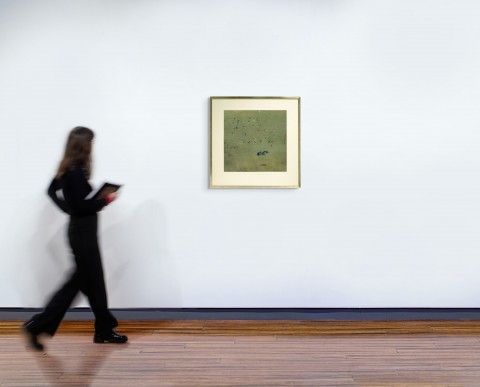YOU YANGS POND, 1969
FRED WILLIAMS
gouache on paper
51.0 x 51.0 cm
signed lower right: Fred Williams
Estate of the artist (GW 612)
Niagara Galleries, Melbourne (label attached verso)
Private collection, Melbourne, acquired from the above in 2012
Fred Williams and John Brack, Art Gallery of South Australia, Adelaide, 21 April – 31 August 1998
Blue Chip XIV: The Collectors’ Exhibition, Niagara Galleries, Melbourne, 6 March – 28 April 2012, cat. 7 (illus. in exhibition catalogue, p. 13)
We are grateful to Lyn Williams for her assistance in cataloguing this work.
‘It is perfectly true, it is monotonous... There is no focal point, and obviously it was too good a thing for me to pass up... the fact [that] if there’s going to be no focal point in a landscape [then] it had to [be built ] into the paint... I’m basically an artist who see things in terms of paint.’1
With their distinctive granite peaks rising above the Werribee plain south-west of Melbourne, the You Yangs – derived from the Aboriginal ‘Wurdi Youang’, meaning big mountain in the middle of a plain – fascinated Fred Williams not only for their sheer scale, but perhaps more significantly, for the ostensibly monotonous nature of the landscape surrounding the monoliths. Seizing the challenge to thus ‘find form in a seemingly featureless landscape… to transform the more familiar landscape motifs into a new pictorial experience’2, Williams proceeded to create some of the most elegant and groundbreaking compositions of his career to date. As Patrick McCaughey observed, the You Yangs series signalled a decisive turning point: ‘They opened up his art, breaking down the monumental image and effect of the Forest paintings and working towards a new fluidity. Where the Forest paintings had been dense – the motif seen in close-up – the You Yangs paintings were broad and extensive, not immediately grand and imposing, but moving towards a more impersonal and abstract order.’3 Accordingly, Williams’ first You Yangs iterations celebrated the flatness of the volcanic plains, viewed from above in fields of minimalist splendour with an absence of sky and horizon line – witness for example, You Yangs II, 1963 (National Gallery of Australia); You Yangs Pond, 1963 ( Art Gallery of South Australia), You Yangs Landscape, 1965 (National Gallery of Victoria); or Knoll in the You Yangs I, 1964 (National Gallery of Australia).
Significantly, Williams worked in various media throughout his career – the technical possibilities and creative innovations of one influencing his work in another – and thus, the You Yangs feature in numerous drawings, etchings, gouaches, as well as oil paintings. A quick-drying medium composed of watercolour mixed with white pigment, gouache was his preferred medium for painting outdoors during the mid to late 1960s. In addition to its convenience and ease of use, in Williams’ hands, gouache also offered something of the richness of oil paint in terms of the pictorial possibilities and textural manipulation it allowed. Here the familiar format of the early You Yangs landscapes is combined with a luscious wintry palette – the scrubby but empty countryside created by a few impasto strokes of the brush across a smooth field of velvety grey. Such expressionist textures also contrast against the balance achieved through the accent on verticals and horizontals, and the classical association they give to the composition. A masterpiece of minimalism, the absence of a horizon line achieves greater harmony – earth and sky are one, supported by the multi-viewpoint and its combination of motifs seen from above and in profile. A superb example of the ‘remote intimacy’4 which Elwyn Lynn identified as a defining characteristic of Williams’ art during this decade, indeed the composition encapsulates well the casual informality of these lyrical landscapes which are ‘…almost Chinese in [the] mixture of immediate gesture, of spontaneous notation, with contemplation and serenity.’5
1. Fred Williams, cited in Mollison, J., A Singular Vision: The Art of Fred Williams, Australian National Gallery, Canberra, 1989, p. 35
2. McCaughey, P., Fred Williams, Bay Books, Sydney, 1980, p. 154
3. ibid., p. 153
4. Lynn, E., ’Poetic Bushland’, The Bulletin, Sydney, vol. 88, no. 4520, 22 October 1966, p. 54
5. ibid.
VERONICA ANGELATOS


